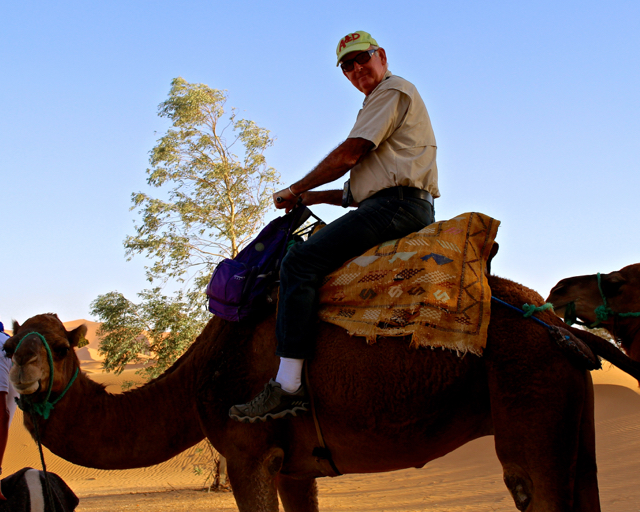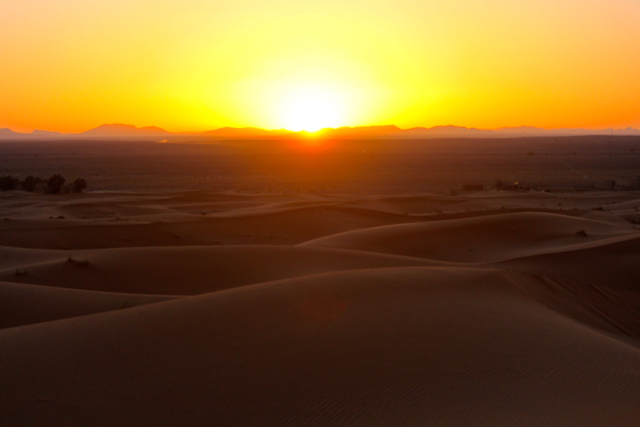Riding into the Sahara Sunset on a Camel,
It is cool this morning. We slept with the French doors leading to a a large covered balcony wide open. There was a fresh breeze. Sometime pre-dawn, we pulled up the duvet. When the sun rose, there was not a cloud in the sky. It will be warm.
Starting With Dessert First.
Sahara Camel Ride into the Sunset
Because this was such a memorable experience, I am fast forwarding to the the end of the day. A small group of us opted to ride into the western edge of the Sahara desert on camels an hour before sunset.This was a beautiful experience. Wrapped in my dampened sarong over my head and shoulder to keep cool and to protect the camera in blowing sand, I mount my camel.
The most exciting part of the ride was when the camel stands and sits, rising on her front haunches, rocking forward, then rocking back, and the body pitches one way and the other.
The sun is low in the sky, the shadows are long, a light sun drop breeze is blowing wispy sand across sand dunes of folds, ridges, swirls, curves, edges and soft slopes of light and shade.
The camels plod through the thick sand, their soft flat feet spread and mold like bean bags over the sand, casting long legged shadows on the dunes.
It is difficult on a plodding camel to take photos and hang on to the saddle. So I take a few photos, deciding instead to relax and absorb the experience, engraving it in my mind. We rest the camels in a small dune valley, and climb by foot to the top of a dune, where our camel drivers spread some blankets for us so that we can enjoy the setting sun.
The sun is so bright, I turn my back to the sun as did the camel drivers until the last few moments. As the sun descends, I watch the the changing colors and shadows of the dunes.
Then we turned towards the setting sun.
Sahara Magic!
Todra - Erfoud, Back to the Beginning of the Day
Today, we boarded the bus at 8:15 and are on our way to Erfoud. We pass by lots of stone desert, camels, and small villages. We are getting used to the sights and are taking fewer photographs. Ali takes the opportunity to tell us about marriage in Morocco and about camels.
About Marriage
Men and women are shedding old customs of arranged marriages and are finding partners on their own. Even during the time of arranged marriages in Morocco, the woman and man always had a choice if they did not find the arrangement suitable to them. Today, It is not uncommon to date, have internet friendships, and get to know each other for several years before marrying. Parents are consulted and told of the young people's choice, and are queried about whether they love the other person for the right reasons (not beauty, not wealth, but compatibility and family).The groom gives a dowery to his bride of what he can afford. Clothing, jewelry, money, gold. That which he gives becomes hers and she can do what she wants with it no questions asked. It is still traditionally the man's responsibility to provide for his wife and family. Even if his wife has a good paying job, she may choose to share her income or keep and spend it herself.
Marriage parties used to last seven days with every day being a party of some sort requiring new clothes for bride and groom. Because of time and money, the marriage parties have been condensed today from none to one or two days. In Morocco, polygamy is permissible, but not widely practiced as it is too costly for a man to support many wives and many children. If the first wife is agreeable (she makes the decision) to have another wife, it may be because she cannot bear children, or she is tired of sexually active husband, or she has much work to do and needs some help, or she is isolated in the country and needs female companionship.
Men and women in Morocco are equal, but have different roles based on physical strength. Women are masters of the interior and all decisions regarding the home are ultimately hers. Men are masters outside. Brains and wisdom come from both genders. This is traditional and fewer in roads have been made in this area, so from my perspective, there are still blue collar, white collar, and pink collar jobs.
In the 1960's when I was a teenager, the employment section in newspapers still advertised jobs for men and women separately according to traditional roles. Women's job included secretary, housekeeper, childcare, nurses, teachers. Men's jobs were engineers, scientists, carpenters, plumbers, advertising, executives, doctors. This of course has changed in America, but there are many who still yearn for the old traditions. Tradition whether overt or subtle is hard to change. Morocco is more liberal and progressive than other Muslim countries it seems, and women if they are educated can choose any profession. There are female police officers and soldiers, breaking the idea of physical strength being limited to males. Change and desire to change is slow.
The engaged couple makes a contract of marriage, and must each willingly say yes to the contract.
About Camels
Female camels gestation is 12 months. Camela (baby camels are not born with a hump, can standup in 1 hour, and suckle in 5. Camel milk does not curdle and contains vitamin C.Camels can travel 40 kilometers a day, carrying 300 kilos. They are smart with good memories. Make an enemy of a male camel, particularly during breeding time, and he will never forget. He will run away. This can be particularly dangerous for someone on his back. No joke!
Camels are grown for meat, farming, caravans in the past, and endurance to carry people in the desert. They can go 20-30 days without water. When given water they can drink approximately 120 liters at a time. Their long legs keep the camels's bellies high away from the rising heat of the sand in the desert. Most of the the camels used for tourism are females and castrated males because they are better natured. If you are lost in the desert trust the camel to lead you.
About Corruption
Today is the first day we have been stopped at the police checkpoint. Automobiles are checked for registration papers and safety reports. We have seat belts. Those in the front seat, driver and guide are belted. Those behind the driver have lap belts, but we have not been asked to wear them and we are in and out of the bus enough that no one has bothered wearing them. One of our group asks the guide if there is corruption with police officers in Morocco and if one must pay to pass the safety inspection. Ali tells us that the police all wear body cams, and if he asks or receives money, both he and the giver will spend time in jail together. More countries that suffer from corruption should do this.About Desert Head Scarves
We stop mid morning for noos-noos a small Moroccan coffee with espresso, milk, and sugar. These are quite good, and I am enjoying this little jolt in the morning. The roadside coffee shop sells authentic souvenirs from Morocco only. Ali demonstrates a variety of scarf wear for men and women for the desert. Each one of us has different configuration to protect the wearer from the sun's rays and the blowing sand. Much of what we think is religious tradition is cultural tradition derived from existing in hot desert climates.Afterwards we took a group photo.
More about education.
Primary education is compulsory, schools are severely overcrowded so instead of turning children away, they come for two hours a day in shifts. Hard to get educated for a global world in 2 hours a day and qualify on examinations for higher education
About Irrigation
In centuries past, the Moroccans learned a technique from the Iranians of transporting water underground in tunnels from the mountain to the villages. We saw the same technique in China in the Taklamakan desert. As the water descends to lower elevations, there are wells that tap into the tunnels by different tribes. |
| Beam me up Scotty! |
 |
| Candles outline the curvature of the tunnels, purposefully dug serpentine style to slow the water. |
 |
| A shaft light illuminates the stairway down. |
The tribes were responsible for keeping debris from silt and falling stones from clogging the flow. To slow the water down so that it did not rush to the end and be wasted, the under ground tunnels snake around to slow the water flow, while the wells themselves appear to be in a straight line. Wells are about 40 meters apart. As the elevation flattens, the well depth decreases. When the water finally reaches the village, one can see much lusher vegetation from the irrigation system and creates a more hospitable environment for the inhabitants.
We were given a demonstration of how the men would bring up the muck to clear debris at the well sites. We also had the opportunity to descend into the tunnel via a tourist access point so that we could better understand the irrigation system. There are some wells still in existence, but most now have been replaced with dams and aqueducts that transport the water. Nomads use the old tunnels for cool homes in the summer months.
 |
| Demonstration of foot power wheel to raise muck buckets |
While we were learning about the wells, we also had the opportunity to make friends with the five month old Camela. She enjoyed having her ears rubbed.
As we entered Erfoud, we stopped at a fossil center. Once a giant seabed this area is rich with fossils. Beautiful slabs, plates, fountains are made from these fossils, over 350 million years old. Very tempting to buy a slab here for counter tops and shipped to the US. Maybe later. We did buy some serving dishes though.
 |
| Add caption |
And of course we ended the day with the Camel ride into the sunset in the Sahara. Fabulous way to end the day.


















































